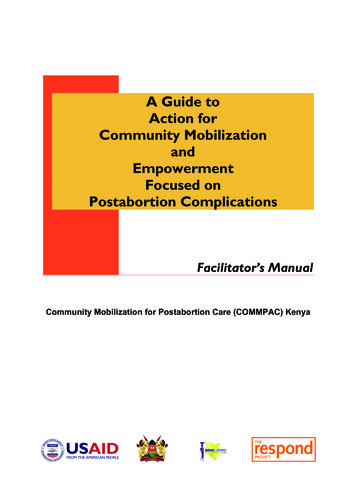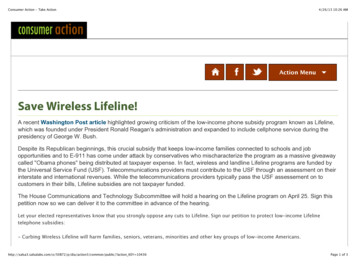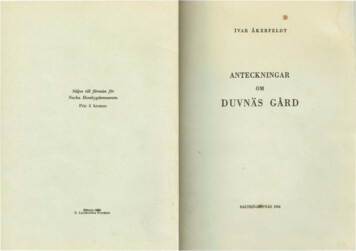
Transcription
A Guide toAction forCommunity MobilizationandEmpowermentFocused onPostabortion ComplicationsFacilitator’s ManualCommunity Mobilization for Postabortion Care (COMMPAC) Kenya
A Guide to Action for CommunityMobilization and EmpowermentFocused on Postabortion ComplicationsFacilitator’s ManualCommunity Mobilization for Postabortion Care (COMMPAC) Kenya
2010The RESPOND Project/EngenderHealth.All rights reserved.The RESPOND Projectc/o EngenderHealth440 Ninth AvenueNew York, NY 10001 U.S.A.Telephone: 212-561-8000Fax: 212-561-8067e-mail: info@respondproject.orgwww.respondproject.orgThis publication was made possible by the generous support of theAmerican people through the Office of Population and ReproductiveHealth, U.S. Agency for International Development (USAID), underthe terms of cooperative agreement GPO-A-00-08-00007-00. Theopinions expressed herein are those of the publisher and do notnecessarily reflect the views of USAID or of the United Statesgovernment.Typesetting and cover design: Elkin Konuk
ContentsAcknowledgments . vIntroduction for the Facilitators . 1Day 1Welcome and Introductions . 11What Is Comprehensive Postabortion Care? . 12What Is Community Mobilization? . 13Introduction to the Community Action Cycle . 14Overcoming Barriers to Participation . 16Gender: Understanding Reproductive Health . 17Gender: Agree-Disagree . 19Gender and Violence . 21Day 2Pregnancy in Our Life (Life Histories) . 25Steps Taken: Problems of Unplanned Pregnancy and Bleedingduring the First Five Months of Pregnancy . 28The Bridge of Possibilities . 29Day 3Prioritizing Needs Found in the Community .Mapping Health Resources and Deciding Where to Go for HealthServices in the Community.Identifying Resources and Constraints .Conclusions to Deciding What to Do (The Bridge of Possibilities) .37404243Day 4Prioritizing the Needs Found in the Community . 53Resolving the Health Problem . 54Day 5Developing a Community Action Plan .Developing an Action Plan .Implementation of an Action Plan .Participatory Evaluation of the Action Plan .63656768Day 6Building Leadership Skills .Identifying Strategies for Resolving Conflict .Couple Communication .Building Financial Management Capacity .Linking to Outside Funding Resources .Proposal Writing .Workshop Closing .71727375767879COMMPAC Facilitator Manual—Kenyaiii
AnnexesAnnex 1: Registration of Participants . 89Annex 2: Pretest/Posttest . 90Annex 3: Sample Energizers . 94ivCOMMPAC Facilitator Manual—Kenya
AcknowledgmentsThis training manual is based on the Guide to Action for Community Mobilization andEmpowerment around Postabortion Complications, which was written and edited by Patricia J.Hammer, in collaboration with Dr. Carmen Monasterios and Kiyomi Tsuyuki under theCATALYST Consortium and PATHFINDER International Project (2004) for use in Bolivia.Portions of this manual were adapted from “How to Mobilize Communities for Health andSocial Change: A Training Guide,” by the Health Communication Partnership; “Keep the Best,Change the Rest: Participatory Tools for Working with Communities on Gender andSexuality,” by the International HIV/AIDS Alliance; Community Gender Facilitation Guide:The Zambian Adaptation of Africa Transformation, by the Health Communication Partnership;and Training Guide for Kenya Health Facility Management Committees and Boards, byFamily Care International.The RESPOND Project and the Society for Women and AIDS in Kenya (SWAK) would like tothank Carolyn Curtis of the U.S. Agency for International Development (USAID) for facilitatingthe collaboration between the Community Mobilization for Postabortion Care (COMMPAC)Project and the CATALYST Project, which led to the development of this communitymobilization guide. The experiences on the project cycle and documents from the CATALYSTProject/Pathfinder International were instrumental in the development of COMMPAC.We appreciate the work of Dr. Carmen Monasterios and Kiyomi Tsuyuki in training MargaritJoseph and Mercy Wahome as trainers on the Bolivian model of the community mobilizationguide; Margarit and Mercy later trained SWAK staff. Thanks also go to the community groupsin El Alto and Santa Cruz, Bolivia, for providing the practical learning opportunity and to theSWAK staff for their input.The contributions of the following members of the COMMPAC team were highly appreciated: Nancy Russell (Senior Technical Advisor, Community Linkages—CARE) Mercy Wahome (Senior Technical Advisor, Community Engagement—EngenderHealth) Dr. Fred Ndede (EngenderHealth) Perpetua Gaciuki (Program Officer, SWAK) Esther Oloo (Regional Coordinator, Rift Valley—SWAK) Laura Subramanian (Program Officer—EngenderHealth) Jane Wickstrom (Technical Programs Team Leader—EngenderHealth) Lynn Van Lith (Senior Technical Advisor, Behavior Change Communication—JohnsHopkins Bloomberg School of Public Health Center for Communication Programs)Special thanks to USAID for providing both financial and technical support to the project.COMMPAC Facilitator Manual—Kenyav
Introduction for the FacilitatorsBackgroundMaternal mortality remains a challenge in Sub-Saharan Africa, where estimates exceed 1,000maternal deaths per 100,000 live births in some countries. Abortion-related complications are amajor cause of maternal death, with a woman dying every eight minutes somewhere in adeveloping country due to complications arising from unsafe abortion or miscarriage. In Kenya,postabortion complications was the fourth leading cause of morbidity among women in 2006.1Given these staggering numbers, interventions to prevent unintended or unwanted pregnanciesin Africa and to ensure access to quality care for women with postabortion complications is apublic health imperative.Successful prevention of maternal deaths hinges on a combination of community awarenessand the availability of adequate and quality emergency obstetric care. In addition to skilledpersonnel, a supportive environment is needed to provide community-facility linkage, essentialdrugs and supplies, equipment, and a referral system.Postabortion care (PAC) is an effective intervention to reduce maternal morbidity andmortality. PAC contributes to improving maternal survival and reducing unplanned pregnanciesthat may result in repeat abortion. It is focused on bleeding in the first half of pregnancy that isrelated to unsafe abortion or miscarriage. The three components of PAC include:1. Emergency treatment for complications of spontaneous or induced abortion2. Family planning counseling, service provision, sexually transmitted infection (STI)evaluation and treatment, and HIV counseling and/or referral for testing3. Community empowerment via community awareness and mobilizationCommon barriers to accessing PAC services often include lack of knowledge of sources ofcare, fear of stigma, dissatisfaction with provider attitudes and performance, cost of services,transportation difficulties, and misperceptions among communities regarding PAC and theperceived severity of complications.2 Community mobilization and empowerment for action inprevention of unplanned pregnancies and management of abortion complications are guided bythe three-delay model:1. Delay in recognizing a problem2. Delay in deciding to seek care in an appropriate obstetric facility3. Delay in receiving appropriate care once the person is at the facilityBased on a model implmented in Bolivia, the Community Mobilization for Postabortion Care(COMMPAC) project in Kenya worked with community groups from five divisions of Nakurudistrict in Rift Valley Province from 2005 to 2007. The groups were trained in using thecommunity action cycle (a participatory problem-solving approach involving community12Kenya Ministry of Health. 2008. Annual Health Sector Status Report: 2005–2007.Rasch, V., Huber, D., and Akande, E.O. 2007. Report of the Postabortion Care Technical Advisory Panel.Washington, DC: United States Agency for International Development (USAID), Bureau for Global Health,Office of Population and Reproductive Health, USAID Development Experience Clearinghouse DocID/OrderNo. PN-ADJ-329). Accessed at http://pdf.usaid.gov/pdf docs/PNADJ329.pdf.COMMPAC Facilitator Manual—Kenya1
diagnosis, planning together, implementation of plans, participatory evaluation, and scaling up,as appropriate).As a result of these experiences, the project team found it necessary to revise the trainingguide to expand its focus to work through the Kenya Ministry of Health’s CommunityStrategy in support of community health extension workers (CHEWs) and community healthworkers (CHWs).Important considerations when using this COMMPAC guide1. Begin by getting buy-in from the community and orienting them on the analysis of thecauses and consequences of general problems during pregnancy, unplanned pregnancy, andpostabortion complications.2. Use the community action cycle model to help communities identify their problems andprioritize and solve the major problems relating to PAC.3. Collaborate with different stakeholders and partners in resolving such problems whileenhancing communication in reproductive health within families, between spouses, andamong men, women, and youth.4. Use different strategies/techniques when facilitating the workshop sessions to ensure groupdiversity (literacy level, culture, religion, etc.)5. Consider the community calendar and gender roles and responsibilities when planning theworkshop sessions. This affects availability for and participation in the community actioncycle process.6. Register, observe, and support the participation of the community members to achieve theindicated objectives.7. Ensure that the participants reflect and talk about actual cases of pregnancy complicationsand related experiences in their community during the sessions.8. Ensure that the sessions that facilitate the community’s identification and prioritization ofneeds use a framework that relates to the “three delays.”9. After defining the community’s needs, have the community groups proceed to the nextstep—the development of a community action plan.10. Ensure that the CHWs and representatives of the community are in charge of implementingthe plan.11. Once the implementation and monitoring of the action plans is complete, instruct thegroups to carry out a participatory evaluation by having the community evaluate the successof their action plans.12. Once the participatory evaluation is concluded, have the same groups begin a newcommunity action cycle and continue to address other identified problems.13. Observe whether community empowerment advances with the completion of each cycle.2COMMPAC Facilitator Manual—Kenya
An overview of the community ation cycle is presented in the illusration below.Overview of the Community Action Cycle1. Organize thecommunity for action6. Prepare to scale up2. Explore the health issueand identify priorities5. Evaluate together3. Plan together4. Act togetherFirst Step: Organize the Community for ActionObjectives:1. Orient the community and invite participation.2. Build relationships and create trust, credibility, and a sense of ownership within the community.Second Step: Explore the Issue and Set PrioritiesObjectives:1. Initiate reflection and create dialogue on life-threatening problems in the community related topregnancy with a focus on unplanned pregnancy, incomplete abortion, and postabortioncomplications.2. Know the perceptions and real life experiences of the community in relation to the delays of safemotherhood that contribute to maternal morbidity and mortality; achieve the identification andprioritization of needs in order to propose possible solutions through the creation of a CommunityAction Plan.Third Step: Develop a Community Action PlanObjectives:1. Develop a document that identifies the causes of community-identified problems and organizes themthrough the search of possible solutions.2. Organize the plan while taking into account the health establishments within the area of the projectinfluence, categorizing the problems encountered, and thinking about the three delays.3. Ensure community participation in the application, implementation, execution, follow-up, andevaluation of the plan.Fourth Step: Act Together to Implement and Monitor the Community Action PlanObjectives:1. Apply the proposed solutions to the community needs and problems identified during the previoussteps.2. Proceed with interventions at the health establishment level, to conduct activities relating to healthcenters.3. Using the provided matrix, develop a plan that addresses the themes proposed in the action plan.COMMPAC Facilitator Manual—Kenya3
Fifth Step: Conduct Participatory EvaluationObjectives:1. Know the degree to which the action plan has been implemented.2. Ensure the community itself can identify whether different proposed solutions addressing the needsand problems in the participatory action plan are successful using different techniques (using providedmatrix, mapping, and story telling)3. Ensure the elements are present to initiate a new community action cycle.4. Rise to another level of community empowerment.Sixth Step: Scale UpObjectives:1. Assess the potential to scale up.2. Build consensus and begin the cycle again.Tips for the FacilitatorPrepare yourselfBefore working with communities, it is important for CHEWs and CHWs to consider their ownfeelings about unsafe abortion and related bleeding complications in the first half of pregnancy,as these feelings might affect how they do their work. This training manual is based on theprinciple that the process of change begins with each of us as individuals. As such, it isimportant for the team to become accustomed to talking openly about such matters.Make group sessions accessibleIt is usually easier to work regularly with community members who already belong to groups.However, the most marginalized and vulnerable members of communities are often less likelyto be members of such groups or institutions; therefore, to target these people, the CHW needsto think about how to conduct outreach and how to encourage these community members toparticipate fully in the group work process.It is also important to consider practical ways to make group sessions as accessible as possible.For example, ensure that work sessions are carried out at a time and place that is appropriate,easy, and safe for community members.Build relationships with participantsTo work successfully in the area of reproductive health, it is vital that health care providersbuild trusting relationships with the community groups. Without this, community membersmay be unwilling to share their own experiences and discuss what needs to change.Plan group mobilization sessionsThe ability to arrange a series of sessions will depend on local circumstances but, in general,taking the following steps will be helpful: Work with informal leaders and respected members of the community and ask them to helpconvene sessions. Work with key stakeholders to ensure that community members affected by the issue canattend the sessions. Ask for volunteers to ensure that others come to the sessions. Arrange sessions at places and times where community members already meet. Make any special arrangements to enable people to attend, such as childcare for womenwith children. Welcome everyone, especially new members.4COMMPAC Facilitator Manual—Kenya
Remind everyone about why the group is meeting, what the group is working on, and howit has agreed to work.In subsequent sessions, invite the group to recap the previous session’s discussion, reviewactions taken since the last session, and discuss any issues.Agree on the issues you will discuss and use one or more tools to explore those issues.Agree on recommendations for action arising from the discussion.Summarize the key points.Check participants’ feelings about the session and how to improve it.Make plans for the next session.IntroductionsSome groups may contain community members who know each other well, while others maynot. Whatever the case, it is helpful to begin any group work with activities that help peoplefeel more comfortable with each other. This can involve thinking of fun ways for groupmembers to get to know each other better, such as playing games.Setting ground rulesIt is important to set ground rules because they describe how people will work together. Groundrules are important for any group process, but especially when discussing sensitive subjects.Energy and humorMaintaining participants’ energy during group work is important. Members may feeloverwhelmed by difficult issues, which will reduce their energy levels. Using humor, however,can be a helpful learning tool, because people learn better when they feel more comfortable andrelaxed. The group’s energy and good humor can be maintained through the use of energizersand icebreakers. (Examples are offered in Annex 3.)Key skillsA critical part of the process is to find ways to help people work together productively. To dothis, facilitators need skills in the following:1. Active listening—Active listening means more than just hearing what a person said. Itmeans letting people know that they are being heard and understood. Active listeningencourages people to be more open in sharing their experiences, thoughts, and feelings.Active listening involves the following: Using body language and facial expressions to show interest and understanding. Listening not only to what is said, but also to how it is said, by paying attention to thespeaker’s body language. Asking questions of the person who is speaking, showing a desire to understand. Summarizing the discussions to check understanding of what has been said.Participants also need good listening skills. From the start, it is important to make it clearthat the purpose of the sessions is to encourage discussion among participants, rather thanbetween participants and the facilitator.2. Effective questioning—Effective questioning involves the following: Asking open-ended questions; for example, using why, what, when, where, who, andhow to propose a question. Asking probing questions, which follow people’s answers with further questions thatlook deeper into the issue or problem.COMMPAC Facilitator Manual—Kenya5
Asking clarifying questions by rewording a previous question.Asking questions about how people feel, not just what they know.3. Facilitating group discussions—Facilitating discussions is another basic skill formobilizing communities. This skill is needed to increase participation in group discussionsand to ensure that members are given the opportunity to express their interests. Goodfacilitation helps to improve the quality of discussions and problem solving. It also helpsgroups to agree on changes that are needed and commit to acting on them.4. Clearly introducing each session—It is important to provide an introduction andexplanation of the objectives and what will be discussed before each session. This shouldbe clear and followed by simple instructions. It is important to check that the participantshave understood what you have said and whether they have any questions. If there arespecific tasks to be completed in small groups, take time at the beginning, before they havestarted the task, to go around to each group and check that they are clear about what to do.5. Involving everyone—Helping everyone to feel comfortable taking part in discussions is animportant part of facilitation. This involves paying attention to each member’s level ofparticipation. There may be many reasons why someone is quiet during a discussion. Theperson may be shy or ill, or he/she may simply be thinking deeply. In general, it is a goodidea to try to bring quiet group members into the discussion, for example, by asking themdirect questions. If someone is very talkative, you can ask him/her to allow others to takepart. One way to encourage full participation is to ask every member to say something inturn or to break into pairs or small groups.6. Guiding the discussion and staying focused—Help the group to explore issues by askingprobing questions and encouraging the expression of different points of view. Summarizethe discussion (checking for areas of agreement and conflict) and note any action points thathave arisen. A key task is to help the group stay focused. If the group seems to be losing itsfocus, remind them of the objectives for the activity and the issues that are being addressed.Posting on the wall a “parking bay” (a sheet of flipchart paper on which to “park” a topicfor future discussion) is also important, to address issues that come up but that may not berelevant to the current discussion. These items should be revisited later.7. Managing conflict—Talking about unsafe abortion and bleeding in the first half ofpregnancy may give rise to disagreements in the group. Facilitators need to welcome thiskind of disagreement, anticipate it, identify safe ways to respond, and move forward. Often,it is through disagreement with others that we come to better understand our own thoughtsand feelings. But there may be situations when disagreement turns into conflict. When thisis the case, people put their energy into defending their own positions rather than exploringthe issues with each other. Helping the group to manage conflict is a key role for thefacilitator. The following are examples of how to manage conflict: Have people state clearly their concerns and their reasons for the concerns to reduce thedanger of other people making assumptions. Ensure people are listening carefully to others, and, if necessary, have them repeat whatothers said to make sure they heard correctly. Help people identify areas of agreement and shared concern to create common groundso they can come together to resolve a conflict.6COMMPAC Facilitator Manual—Kenya
8. Achieving common ground—It will often not be possible or desirable to achieveagreement among group members. In such cases, ask people to reflect on areas of ‘commonground’ for the group, as well as points of difference that may need further discussion. Thefacilitator or group should also summarize the main points of the discussion and any actionpoints that they have agreed on. Encourage people to thank each other for theircontributions and to celebrate the achievements of the meeting.9. Dealing with challenges—Facilitating a group meeting will almost certainly mean dealingwith negative or disruptive behaviors, such as participants chatting amongst themselves or afew vocal individuals dominating the discussion. Reminding the group of its ground rulesand asking everyone to be responsible for maintaining them is a good way to deal with suchdisruptions.10. Challenging harmful points of view—Members of the group are likely to have strongviews about issues such as bleeding in pregnancy. Everyone has a right to their opinion, butit is the role of the facilitator to see that harmful points of view are challenged, ideally, byparticipants themselves, but, failing that, by the facilitator. The best way to do this is notonly to repeat the core values and messages of the training, but also to give the person achance to think more deeply about their point of view and the impact that it has. Thefacilitator should also encourage everyone to listen more closely to different points of viewin the group. This can be difficult, but it is vital in helping members to work towardspositive change. Some things the facilitator may say or do to deal with such a situation mayinclude the following: Ask for clarification. For example, say: “I appreciate you sharing your opinion with us.Can you tell us why you feel that way?” Seek a different point of view. For example, say: “Thank you. So at least one personfeels that way. What do the rest of you think?” If another point of view is not offered, provide one. For example, say: “I know that a lotof people disagree with that statement. Most women and men I know feel .” Offer facts that support a different point of view. For example, say: “The facts areclear” and elaborate on them.It is important to remember that changing deeply held views is difficult. Even after thefacilitator has used these four steps, it is unlikely that the group member will openly changehis/her opinion. But, by challenging the statement, the facilitator has provided another pointof view that the member will be more likely to think about and, it is hoped, adopt later.11. Using role plays effectively—Role plays (including acting, singing, and dancing) can behelpful. Role-playing demands more from people than just talking about an issue. Itinvolves going deeper into what they think and feel. Ways to ensure that role plays areuseful and effective include the following: Remain aware of not only what is happening in the scene, but how the rest of the groupis reacting. Pause a role play when there is an opportunity to discuss a key issue. Then ask questionsof the actors and the other participants about what is happening, why it is happening, andthe implications—and use those questions to develop key learning points. Support humor as a way to relax people, but ensure that it does not take over and losethe point of the role play.COMMPAC Facilitator Manual—Kenya7
The Do’s and Don’ts of FacilitationDo Introduce yourselfListenListen actively to othersObserve nonverbal communicationCreate a relaxing environmentBe flexibleBe patientRespect different viewpointsTalk slowly and clearlyBe tolerantBe open and transparentBe practicalHave a good understanding of the issuesBuild trust with peopleDiscussAsk open-ended, problem-posing questions,such as “why do you believe that?”Focus on the issue not the personInvolve everybodyTalk calmlyUse visual aids where possibleGive constructive feedbackLearnRelaxGive people time to thinkShow you understand what they have said byrepeating itSummarizeWork with peopleFacilitateUse appropriate body languageEmpathize and be supportiveShare: time, food, ideas, and knowledgeDon’t Forget to tell people who you are and why you are thereTalk all the timeInterrupt othersJust listen to what is saidAllow constant distractionsBe rigidBe impatientDismiss or ignore different viewpointsMumbleBe intolerantBe secretiveBe theoretical all the timeTry and fake your way throughLet people down or make promises you can’t keepKeep silent or refrain initiativeAsk “yes” or “no” questionsFocus on one person aloneExclude some people or favor othersShoutJust talk, without using visual aids to engage peopleGive destructive feedbackLecture or pretend you know all the answersRushInterrupt silences too oftenWorry about asking for clarificationJust listen without ever summing up the points raisedEncourage the participants to be engaged and support themDominate or lead people down your own agendaBe physically dominatingJudgeKeep everything to yourselfNote: This chart is adapted from the content of a wor
community action cycle (a participatory problem-solving approach involving community 1 Kenya Ministry of Health. 2008. Annual Health Sector Status Report: 2005–2007. 2 Rasch, V., Huber, D., and Akande, E.O. 2007.











